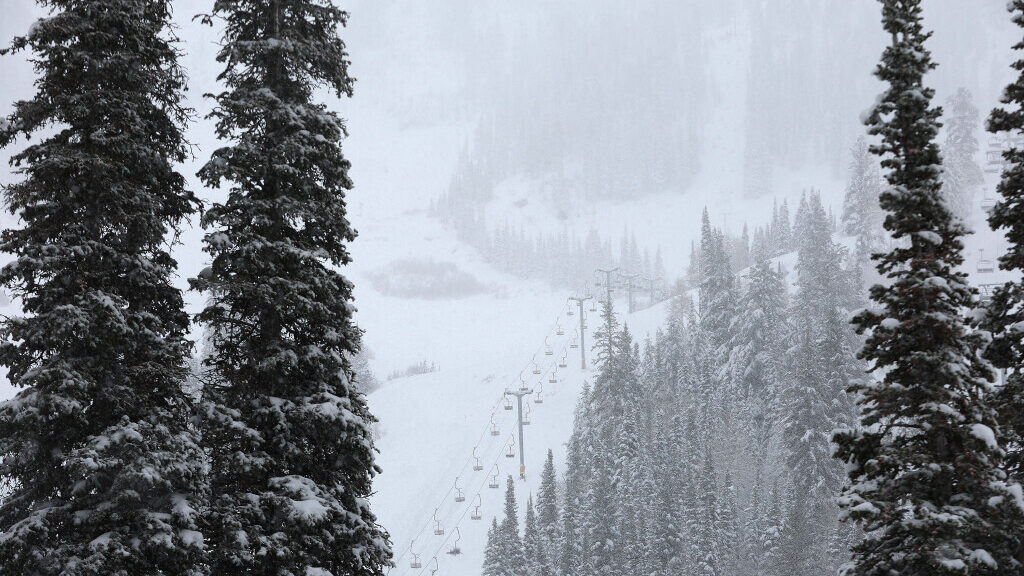Ski safety tips to keep you on the slopes
Dec 29, 2023, 8:00 PM

A ski lift travels through Snowbird Ski Resort. Practicing ski safety is important for everyone on the mountain. (Jeffrey D. Allred/Deseret News)
(Jeffrey D. Allred/Deseret News)
SALT LAKE CITY — According to University of Utah Health, most ski injuries happen at the end of the day. One sports medicine expert says that these increased injury rates are caused by tougher conditions and muscle fatigue.
Travis Maak, the associate professor and director of the Orthopaedic Sports Medicine Fellowship, previously told The Scope that at the end of the day, temperatures begin to cool. The drop in temperatures causes snow to harden again, making for more difficult terrain,
Secondly, Maak said that end of the day muscle fatigue causes ligaments to overcompensate. He added that ACL injuries are common in skiers, dubbing them “the skier’s injury.”
Regardless of whether you’re skiing in the backcountry or within resort boundaries, there are steps you can take to remain safe and on the slopes.
Pre-ski conditioning
U of U Health said it is important to take proper care of yourself before, during and after the season.
According to Linda Scholl, a physical therapist with U of U Health, you should begin your conditioning routine with a 10-minute cardio warm-up.
Following your warmup, Scholl recommended performing a few exercises that target the muscles used while skiing, strengthening them to prevent muscle fatigue that can lead to injury on the slopes.
According to the National Institute of Health, greater levels of physical fitness can lead to longer endurance. Possessing better endurance means that you’ll be able to ski longer with less muscle fatigue. Additionally, it can lead to faster post-exercise recovery.
Ski safety at the resort
Brian Head Ski Resort provided some ski safety tips in a press release sent to KSL NewsRadio earlier this year.
If you plan to ski in the resort, always obey all posted signage. Remain within ski resort boundaries and do not venture down trails that are marked as closed.
Venturing into terrain that has not been opened by resort ski patrol personnel can have consequences. The trails may not have enough snow coverage or dangerous conditions may exist.
Ski runs within your range of ability to ensure you remain in control.
Maintain a controllable speed at all times. According to Brian Head’s press release, you need to ensure that you can stop, slow down, or change directions at any time. Remember that the downhill skier always has the right-of-way.
Remain vigilant at all times. Unmarked obstacles can exist, even on open terrain.
Finally, avoid skiing too close to trees, as tree wells and deep snow can exist. While leaving groomed runs to ski through deep, fluffy powder can be thrilling, it can also be dangerous. According to the National Ski Area Association, if someone falls head first into a tree well or deep snow, they risk suffocation.
The NSAA said that deep snow accidents are preventable. Always take a partner when venturing off-piste.
Backcountry ski safety
If you plan to ski in the backcountry, make sure you take the proper equipment with you. Additionally, never go alone. Always take someone experienced and knowledgeable about backcountry skiing and avalanche safety.
According to the Utah Avalanche Center, everyone who ventures into the backcountry needs to take their own avalanche beacon, shovel and probe. A full list of essential and recommended equipment can be found on their website.
Steve Christy from Backcountry Access told REI’s blog that avalanche beacons used by recreational skiers should be replaced every five years.
Additionally, before you head out for a day on the slopes, you should receive training on avalanche safety. According to the Utah Avalanche Center, “Avalanche education is a lifelong journey and the best way to ensure you have the skills to safely travel in the backcountry.”
The center provides several education courses. Alternatively, courses are presented by Snowbird, the University of Utah and Wasatch Backcountry Rescue.
Finally, regardless of the terrain you choose to ski, you should dress warm to prevent injuries related to cold temperatures. Always wear a helmet to prevent head injuries.
Related:












